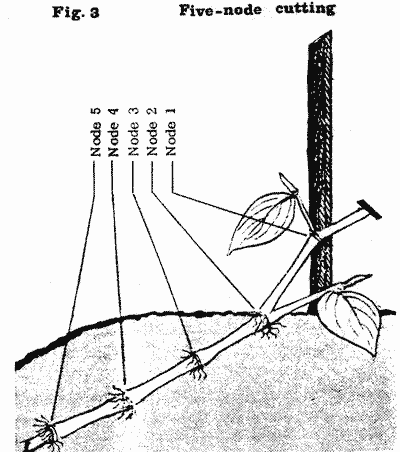
GROWING PEPPER
SCIENTIFIC NAME: Piper nigrum
FAMILY: FAMILY: Piperaceae
PLANTING THE CUTTING

The nursery is prepared by thoroughly digging over the soil to prepare beds composed of topsoil and compost. (Inorganic fertilisers are not recommended, as they are liable to cause scorch on the young cuttings).
Initially, heavy shade is supplied, (at any height convenient for working). The cuttings are dusted with Hortomone a (rooting hormone) and are then planted in furrows one-foot apart at an angle downwards with four nodes buried. The beds must be watered frequently to maintain a high humidity and a damp soil. As the cuttings start to root and grow, the shade can be gradually reduced.
After about 4-6 weeks, the cuttings are ready for lifting. Those with a poorly-developed root system should be discarded.
Fresh cuttings can also be planted directly into the field, but rooted cuttings from a well-shaded nursery are better. It is preferable that they be planted on small mounds as shown in Fig.3.
Cuttings should be planted near the surface with four nodes below ground level, ref. Fig.3. The soil in the planting hole, into which the cutting is placed, should be pressed firmly around the base of the stem.
Immediately after planting, the cuttings should be under heavy, but well-ventilated shade. Fern fronds (preferably Gleichenia linearis) provide satisfactory shade. Care should be taken to ensure that the fronds do not fall on the planted cutting. The shade can be thinned out to about 50% after 4 weeks, 75% after 6 weeks, and removed completely after 8 weeks, by which time the cuttings would have established themselves.
DATE: July 1992
* * * * * * * * * * * * *
